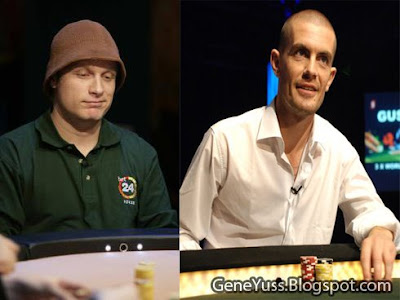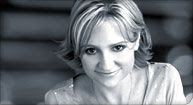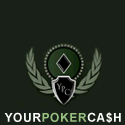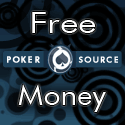Theo Jorgensen and Gus Hansen will battle it out in a boxing match in Copenhagen on February 21.

Gus and Theo have a prop bet on the outcome of the match; if Gus wins, Theo will pay him $25,000, if Theo wins, Gus will pay him $35,000. Gus is younger and in better shape that's why the odds are not 50/50.
You can watch a video of Jorgensen training, it is in Danish though.
Here is a conversation between Gus Hansen and high stakes pro Ilari "Ziigmund" Sahamies on Full Tilt Poker;
Gus Hansen: ziigmund
Ziigmund: y
Gus Hansen: ziigmund
Gus Hansen: is there any chance you are up for a boxing match in copenhagen
Gus Hansen: you vs Lars luzak
Ziigmund: why u want_?
Ziigmund: u hate me so much?
Gus Hansen: do you know that me and
Theo are going to box
Ziigmund: no i didnt
Gus Hansen: nope Im boxing agaisnt theo
Gus Hansen: on the 21st of february
Gus Hansen: in Denmark
Ziigmund: i cannot take against luzak
Gus Hansen: 3000 people watching
Gus Hansen: Zupp
Gus Hansen: do you know zupp
Ziigmund: lol
Gus Hansen: he might be too big for you
Gus Hansen: maybe Uffe holm is better for
you
Ziigmund: haha
Gus Hansen: he is a danish
stand-up/pokerplayer
Gus Hansen: Im actually very serious
Gus Hansen: Ziiggy
Ziigmund: y0
Gus Hansen: ziiggy
Gus Hansen: are you up for it
Gus Hansen: you might get beat
Gus Hansen: ziiggy vs Zupp
Gus Hansen: just the sound of it sounds
great
Ziigmund: lets talk latertr
Ziigmund: haha
Gus Hansen: trying to call you from theos
Phone
Gus Hansen: ziggy pick up
Ziigmund: wait
Gus Hansen: Ziggy
Gus Hansen: think about
Gus Hansen: it
Gus Hansen: lots of girls
Free $100 Bankroll at Full Tilt Poker.

Gus and Theo have a prop bet on the outcome of the match; if Gus wins, Theo will pay him $25,000, if Theo wins, Gus will pay him $35,000. Gus is younger and in better shape that's why the odds are not 50/50.
You can watch a video of Jorgensen training, it is in Danish though.
Here is a conversation between Gus Hansen and high stakes pro Ilari "Ziigmund" Sahamies on Full Tilt Poker;
Gus Hansen: ziigmund
Ziigmund: y
Gus Hansen: ziigmund
Gus Hansen: is there any chance you are up for a boxing match in copenhagen
Gus Hansen: you vs Lars luzak
Ziigmund: why u want_?
Ziigmund: u hate me so much?
Gus Hansen: do you know that me and
Theo are going to box
Ziigmund: no i didnt
Gus Hansen: nope Im boxing agaisnt theo
Gus Hansen: on the 21st of february
Gus Hansen: in Denmark
Ziigmund: i cannot take against luzak
Gus Hansen: 3000 people watching
Gus Hansen: Zupp
Gus Hansen: do you know zupp
Ziigmund: lol
Gus Hansen: he might be too big for you
Gus Hansen: maybe Uffe holm is better for
you
Ziigmund: haha
Gus Hansen: he is a danish
stand-up/pokerplayer
Gus Hansen: Im actually very serious
Gus Hansen: Ziiggy
Ziigmund: y0
Gus Hansen: ziiggy
Gus Hansen: are you up for it
Gus Hansen: you might get beat
Gus Hansen: ziiggy vs Zupp
Gus Hansen: just the sound of it sounds
great
Ziigmund: lets talk latertr
Ziigmund: haha
Gus Hansen: trying to call you from theos
Phone
Gus Hansen: ziggy pick up
Ziigmund: wait
Gus Hansen: Ziggy
Gus Hansen: think about
Gus Hansen: it
Gus Hansen: lots of girls
Free $100 Bankroll at Full Tilt Poker.



 Most Pot Limit Omaha players know that Omaha is a game of "the nuts." In a multi-way pot, the winning hand is, more often than not, the best possible hand out there. When you start with four cards, you have six different possible two-card hands. This increases the chances that someone is holding the nuts. What many beginning Pot Limit Omaha players do not understand is that Omaha is really a game of redraws.
Most Pot Limit Omaha players know that Omaha is a game of "the nuts." In a multi-way pot, the winning hand is, more often than not, the best possible hand out there. When you start with four cards, you have six different possible two-card hands. This increases the chances that someone is holding the nuts. What many beginning Pot Limit Omaha players do not understand is that Omaha is really a game of redraws. In an effort to simplify my decisions, every single time it's my turn to act, I try to run through the same script in my head:
In an effort to simplify my decisions, every single time it's my turn to act, I try to run through the same script in my head:









 It is very difficult to calculate the exact odds of hitting a drawing hand when you're sitting at the poker table. Unless you're a genius with a gift for mathematics like Chris Ferguson, you will not be able to do it. That leaves two options for the rest of us: The first option is to sit at home with a calculator, figure out the odds for every possible combination of draws, and then memorize them. That way, no matter what situation comes up, you always know the odds. But for those of us without a perfect memory, there's an easier way. Here is a simple trick for estimating those odds.
It is very difficult to calculate the exact odds of hitting a drawing hand when you're sitting at the poker table. Unless you're a genius with a gift for mathematics like Chris Ferguson, you will not be able to do it. That leaves two options for the rest of us: The first option is to sit at home with a calculator, figure out the odds for every possible combination of draws, and then memorize them. That way, no matter what situation comes up, you always know the odds. But for those of us without a perfect memory, there's an easier way. Here is a simple trick for estimating those odds.




















